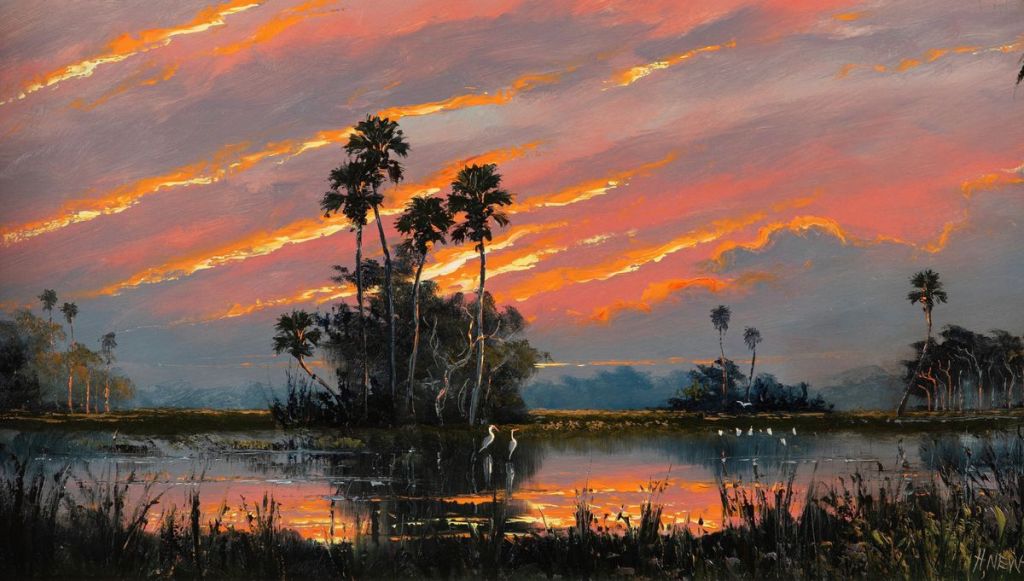[ad_1]
With the exception of national parks, wildlife sanctuaries, and conservation-minded communities fighting for the sake of still pristine lands, much of Florida has given way to development in tandem with exponential population growth. While similar scenarios play out across the country, the dynamic is arguably most dire in the Sunshine State, where—according to certain measures—900 people relocate a day, notably from northern cities. The resulting demand for non-stop building has taxed the fragile soil bed while also threatening the habitat of hundreds of animal species that have long claimed the state as their home.
While contemporary photographers and writers have found inspiration in the fleeting specter of wild Florida, little has been known until recently about a group of regional painters who captured the state’s changing landscape during the 1950s and ’60s. Aware of the beauty of their surroundings, these artists worked prolifically—yet went largely unknown, primarily because they were African-Americans working in the segregated South. This is the case no longer, however, thanks to “Living Color: The Art of the Highwaymen,” an exhibition on view at the Orlando Museum of Art (through May 10) that surveys their tremendous output.
As history tells it, painting offered an alternative to the back-breaking labor in the citrus groves that was more widely available to minorities in the Jim Crow era. And without galleries, much less museums to represent them, these artists—known as the Highwaymen—sold their work out of their car trunks, peddling $20 paintings along Highway 1 and other freshly-minted thoroughfares. But despite their talent, financial successes, and ability to—through their choice of subject matter and vivid palettes—reflect the paradise of Florida, critical recognition eluded the Highwaymen, who some ascribed as purveyors of “motel art.” Attitudes eventually shifted, however, culminating in the induction of all 26 members of the group into the Florida Artists Hall of Fame in 2004.
Sixteen years later, Gary Monroe, author of several books about the Highwaymen, has drawn from private collections featuring the most prominent painters in the group, led by Alfred Hair (1941–70) and Harold Newton (1934–94). The two Fort Pierce natives were protégés of local landscape painter A. E. “Bean” Backus, who welcomed them into his studio and shared his knowledge.
Set midway down Florida’s eastern seaboard in St. Lucie County, Fort Pierce was named for the eponymous army post erected during the Seminole Wars. The postwar population boom had found its way to Fort Pierce and included African-Americans looking for a better life. When the young Hair ventured into Backus’s studio, he could immediately identify the indigenous scenery splashed across so many colorful canvases—windblown palms and tropical sunsets, cherry red Poinciana trees and verdant tracts of swamp-fed fields.
While emulating his mentor, Hair forged his own style. In the “Living Color” show’s catalogue, Hansen Mulford, senior curator at the Orlando Museum, describes the artist’s work as having a “sense of frenetic energy.” It’s palpable in the stormy, pointillist waterscape of St. Lucie River with Foreground Oak— “where even the egrets appear restless, circling over a dark clearing.” In Washer Woman with Poinciana, a female silhouette struggles to hang her laundry by a wind-buffeted poinciana tree. Both are examples of a technique Hair perfected and dubbed “fast painting.”
Newton joined the Hair-Backus orbit and honed the richly detailed and brilliant-colored compositions that define the Highwaymen iconography. Its practitioners ultimately grew to more than two dozen, including one woman—Mary Ann Carroll—all breaking down racial barriers in a way with their potent strokes of paint.
Similarities that abound in the 100 paintings on view are circumstantial. The Highwaymen typically worked together, sharing advice and affordable supplies: industrial Upson boards for canvas and carpenters’ molding for makeshift frames. And while subtle differences may be detected in each artist’s approach, a signature melancholy emerges from the collective work—from Livingston Robert’s Moonlight River Scene, a study in the haunting colors of night, to Carroll’s lone sailboat dwarfed under luminous skies in Indian River Sailboat at Sunrise.
That the Highwaymen eschewed more provocative themes relating to their time—they painted, after all, through the height of the civil rights movement—is also purposeful. “Images of pain and suffering would not have sold Highwayman paintings,” Monroe, who knew many in the group personally, writes in the catalogue. Rather, their legacy would be to cater the common “longing to experience the Old Florida” with something more than just a picture postcard: an original work of art that, at last, belongs in a museum.
[ad_2]
Source link


